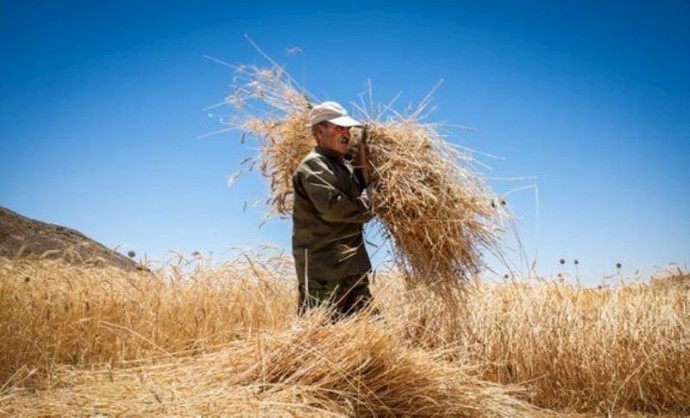Analysis by PMOI/MEK
Iran, September 23, 2019—For the past few years, the government of Iranian regime president Hassan Rouhani claims to be producing the necessary wheat for Iran’s consumption.
However, statistics published by state-run institutions show that self-sufficiency in terms of domestic wheat production is nothing but another ruse by the Iranian regime alongside other propaganda.
The Resalat newspaper wrote on August 6 that the regime’s Agriculture Minister has disallowed the import of wheat since January 2016, according to article 16 of the Agriculture Improvement Act, except temporarily for exports according to customs laws.
However, since 2016, about two to three million metric tons of wheat are imported into the Iranian market every year under different pretexts, including “for export” or “guaranteed purchase.”
According to Agriculture Ministry officials, two to three million tons of wheat for the price of 2,500 to 3,000 tomans per kilo are imported into Iran every year. Simultaneously, Iranian wheat is purchased at a price of 1,700 to 1,720 tomans per kilo. This significant price difference between domestic and foreign products has become the root of controversy and disagreements between authorities on the one hand and a source for massive profits for the terrorist-designated Islamic Revolutionary Guards Corps (IRGC) and other regime insiders involved in the wheat trade on the other.
Needless to say, the losers of such circumstances are Iranian wheat farmers who have to sell their products to the government at ridiculously low prices, or to traders who have the upper hand.
These traders then will mix the wheat with grit and sand, or even water, resulting in enormous profits from the added weight.
“The wheat mafia, with the help of its elements in the Grain Organization, transports the wheat to open storage where it adds grit and sand, or water, to increase the weight of the purchased wheat by thousands of tons, resulting in enormous profits. This has become a widespread procedure in the Khorasan Razavi Province, and in most provinces where wheat is cultivated, ” says Hadi Hashemian, an official from the Justice Department of Golestan Province, northern Iran.
On October 15, Iran’s ISNA news agency quoted the Director of the Federation of Iranian Food Associations saying: “Unfortunately, a widespread corrupt system of mafia is built in the guaranteed purchase of wheat and we’ve warned the Minister of Agriculture about it many times. However, we heard from him that ‘It’s OK. It will fill the pockets of the farmers.’ All the while, we are certain this is not the farmers’ doings but rather some traders who buy the wheat from farmers and resell it to the government, and some officials are also involved.”
All the internal disputes among different factions of the ruling elite is a rivalry of who will be receiving a greater share of profits. Some traders are trying to import more wheat while others seek to purchase the wheat for cheap prices from Iranian farmers and resell it at higher prices for huge profits. And Iranian regime officials are heavily involved in the game.
The Tabnak website, close to former IRGC chief Mohsen Rezaii, writes: “Unchecked import of agricultural products over the past few years has resulted in massive damages to farmers and made them criticize the current situation. Statistics show that over the past year, agricultural products have been at the top of imported goods and approximately $5 billion of the country’s budget has been spent on importing agricultural products.”
Quoting an Iranian farmer who was addressing Iran’s agriculture minister, Tabnak further wrote: “A farmer from Langarud criticized the Agriculture Minister’s record during his visit. ‘I’m saying it frankly to you, the goal of the government and the minister is to destroy the farmers. Who are the Aghazadehs?’” Aghazadeh is a colloquial term that means nobly-born, and refers to the sons and daughters of the well-connected political elite.
The Iranian farmer continued: “Why the unchecked import [of agriculture products]? Why is the price of rice so low?”
Tabnak continues to describe the scene that followed: “The Agriculture Minister, lacking a proper response, said to his associate, referring to the discontent farmer: ‘Give him some of this bran!’”
The fake claim of becoming self-sufficient in producing wheat is, in fact, more unchecked import, and of course, more opportunities for the ruling elite to profit. Just looking at the number 700,000 Iranian farmers leaving their lands per year to live on the outskirts of urban areas in the hopes of getting a better job is revealing enough.
This goes alongside other measures of the mullahs’ regime and how they have destroyed Iran’s economy.
Back in July, Aziz Akbarian, chair of the Industrial Commission in the mullahs’ Majlis (parliament), rejected the economic statistics presented by Iranian regime President Hassan Rouhani.
“What is interpreted from the domestic and international statistics is that this year our economic growth is negative 6.5% and the inflation rate is 40%. Therefore, how on earth did Rouhani come up with these numbers and spoke of economic growth? We will face an economic depression by the end of this year," he said.
“Not only the government doesn’t supply manufacturers with currency. It also prevents them from finding these supplies,” Akbarian added.
“Various work regulations are issued to improve the working environment, but they add footnotes to these regulations that prevent the job from being executed,” Akbarian continued referring to the inefficiency of work regulations.
“Most of the problems in the manufacturing sector are due to the instability of governmental decisions,” Akbarian added.
While criticizing the now sanctioned Central Bank of Iran for stating its mission as controlling the currency exchange rate, Akabarian said, “This very policy caused the dollar's value to go from 30,000 rials to 130,000 rials and the process of increasing continues.”





